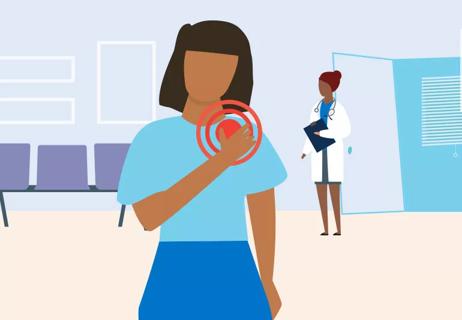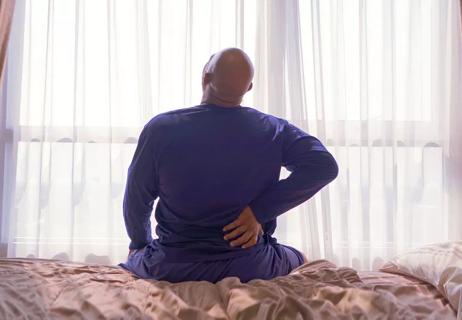3 tips to help you sleep easier

Beware the night. If you’ve injured or torn a rotator cuff muscle, that warning probably sends a familiar shiver down your spine.
Advertisement
Cleveland Clinic is a non-profit academic medical center. Advertising on our site helps support our mission. We do not endorse non-Cleveland Clinic products or services. Policy
Shoulder injuries that barely register pain during the day can turn absolutely monstrous when the moon and stars shine above. It’s a terrifying reality that can keep you up at night. (Insert werewolf howl here.)
It doesn’t have to be such a scary situation, though — especially if you follow these tips from physical therapist Kelly Kinsey, MSPT, AT.
Four muscles and a network of tendons reside in your rotator cuff. Together, they help you lift and move your arms. You’re not doing something as simple as stacking cans on a pantry shelf without your rotator cuff doing its thing.
A rotator cuff tear happens when a tendon connecting your shoulder muscle to your skeletal frame pulls away from your bone. Tears can be partial (leaving some connection) or a complete detachment.
Most often, tears occur over time with the repetitive movement that comes with day-to-day life. An accident, such as a fall, also can cause an injury.
Signs of a rotator cuff tear include:
That’s a little bit of a mystery. Healthcare professionals have some ideas why it hurts more at night — primarily related to blood flow and muscle tension — but there’s really no definitive reason, says Kinsey.
Advertisement
“Your body is quieter at night,” says Kinsey, “so you’re more likely to hear the thing in your body screaming the loudest.”
Various exercises and stretches can help you restore flexibility and reduce pain in an injured rotator cuff and shoulder — but it takes time, cautions Kinsey.
In the meantime, here are some ways to make it hurt less … particularly at night.
Peacefully lying down in bed might seem like a relatively mild physical act, but it’s enough to send pain levels shooting through the roof if you’re dealing with a torn rotator cuff. The reason? Gravity.
“Oftentimes, when people lie down, your position and gravity increases the pulling and tugging on the tear,” says Kinsey. “It might not seem like much, but you’ll feel it.”
The solution? Props.
If you sleep on your back, slip a pillow or folded blanket beneath your arm to keep your elbow from dropping down to the bed. That slight dip is enough to put strain on your shoulder. “Try to support your arm and lift it up so it’s sitting midline with your body,” says Kinsey.
Are you a side sleeper? If so, Kinsey recommends sleeping with your injured shoulder up. Then, build a “pillow wall” in front of you and rest your arm on that puffy shelf. (The wall should be the height of your body.)
In each case, the pillows place your aching shoulder in a more neutral position that reduces tension on the joint. “That extra support for your shoulder blade and arm is one of the best ways to find relief,” says Kinsey.
And if you sleep on your stomach … well, stop it. The position typically puts your arm and shoulder in an awkward position that can dial up the pain.
Your aching rotator cuff might respond to cold therapy. Of course, it may also feel better with heat. “We have people experiment with them both to see which helps more,” says Kinsey. “This isn’t a one-size-fits-all situation.”
Ice or cold therapy often works better on an injury, or acute tear. Warmth tends to soothe chronic pain related to long-term wear by increasing blood flow to the area to help with healing.
Over-the-counter pain relievers such as Tylenol® — or Advil® and other NSAIDs (nonsteroidal anti-inflammatory drugs) — can help manage swelling and ease pain. For relief while sleeping, take the medication about an hour before bedtime.
As always, it’s best to check with your doctor before taking medications. You also want to avoid making NSAIDs a daily habit.
Advertisement
Learn more about our editorial process.
Advertisement

Rest, physical therapy, pain relief medication and steroid injections may be able to help instead

Improve your shoulder’s range of motion before moving to strengthening workouts

The short answer from an orthopaedic sports medicine surgeon

Looking down at your smartphone or computer screen can stress muscles in your neck, shoulders and back

Tendinopathy tends to get better with rest, ice, pain management and physical therapy

It could be an injury, arthritis, a bone infection or even the position of your collarbone

Don’t ignore obvious warning signs of more serious shoulder issues

Find the right sleep position to tame your joint pain

Babies can get congested easily, but you can calm their cough by keeping them hydrated, using nasal drops and running a humidifier

Weight loss may cause loose, sagging skin and muscle loss to your rear

Several conditions, like vitiligo and fungal infection, can cause a loss of pigmentation, leading to white spots or patches on your skin